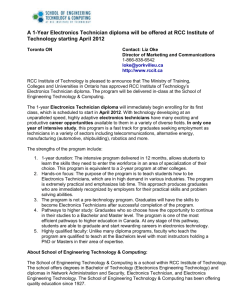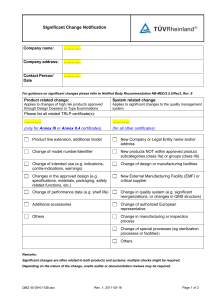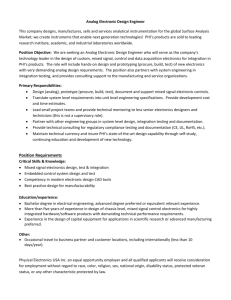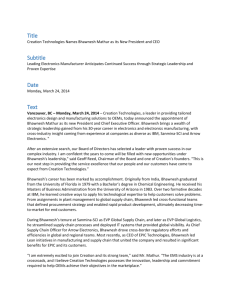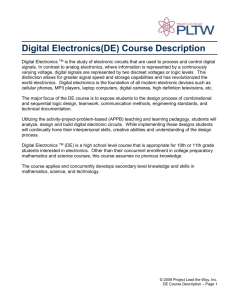Annual Update - Bakersfield College
advertisement
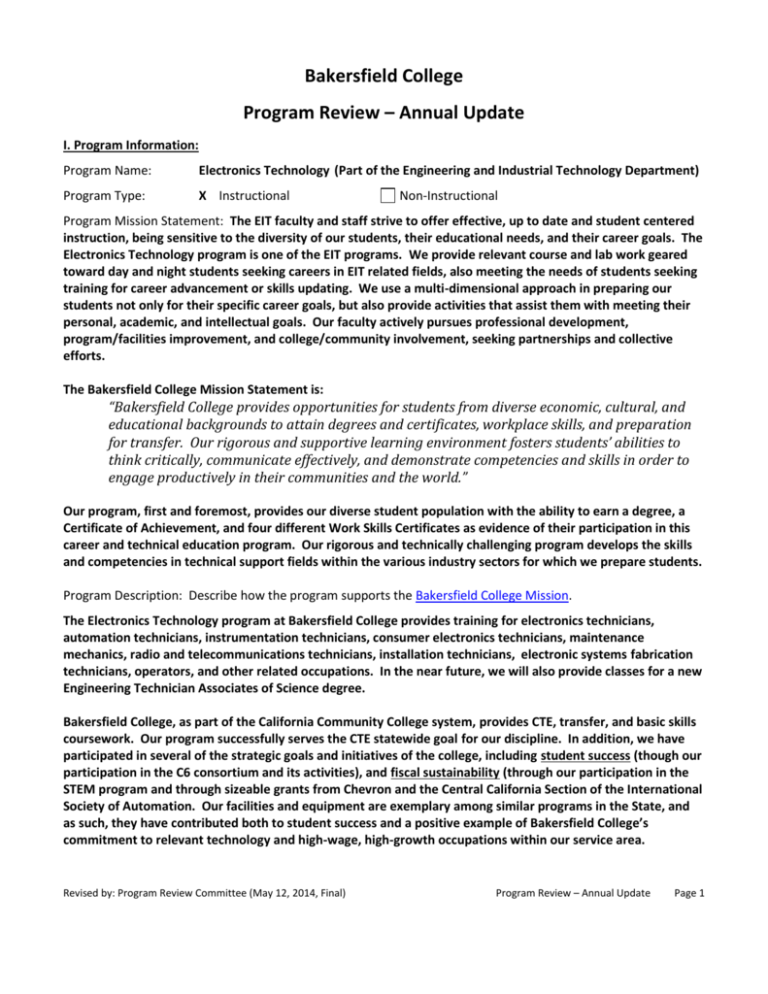
Bakersfield College Program Review – Annual Update I. Program Information: Program Name: Electronics Technology (Part of the Engineering and Industrial Technology Department) Program Type: X Instructional Non-Instructional Program Mission Statement: The EIT faculty and staff strive to offer effective, up to date and student centered instruction, being sensitive to the diversity of our students, their educational needs, and their career goals. The Electronics Technology program is one of the EIT programs. We provide relevant course and lab work geared toward day and night students seeking careers in EIT related fields, also meeting the needs of students seeking training for career advancement or skills updating. We use a multi-dimensional approach in preparing our students not only for their specific career goals, but also provide activities that assist them with meeting their personal, academic, and intellectual goals. Our faculty actively pursues professional development, program/facilities improvement, and college/community involvement, seeking partnerships and collective efforts. The Bakersfield College Mission Statement is: “Bakersfield College provides opportunities for students from diverse economic, cultural, and educational backgrounds to attain degrees and certificates, workplace skills, and preparation for transfer. Our rigorous and supportive learning environment fosters students’ abilities to think critically, communicate effectively, and demonstrate competencies and skills in order to engage productively in their communities and the world.” Our program, first and foremost, provides our diverse student population with the ability to earn a degree, a Certificate of Achievement, and four different Work Skills Certificates as evidence of their participation in this career and technical education program. Our rigorous and technically challenging program develops the skills and competencies in technical support fields within the various industry sectors for which we prepare students. Program Description: Describe how the program supports the Bakersfield College Mission. The Electronics Technology program at Bakersfield College provides training for electronics technicians, automation technicians, instrumentation technicians, consumer electronics technicians, maintenance mechanics, radio and telecommunications technicians, installation technicians, electronic systems fabrication technicians, operators, and other related occupations. In the near future, we will also provide classes for a new Engineering Technician Associates of Science degree. Bakersfield College, as part of the California Community College system, provides CTE, transfer, and basic skills coursework. Our program successfully serves the CTE statewide goal for our discipline. In addition, we have participated in several of the strategic goals and initiatives of the college, including student success (though our participation in the C6 consortium and its activities), and fiscal sustainability (through our participation in the STEM program and through sizeable grants from Chevron and the Central California Section of the International Society of Automation. Our facilities and equipment are exemplary among similar programs in the State, and as such, they have contributed both to student success and a positive example of Bakersfield College’s commitment to relevant technology and high-wage, high-growth occupations within our service area. Revised by: Program Review Committee (May 12, 2014, Final) Program Review – Annual Update Page 1 II. Program Assessment (focus on most recent year): A. How did your outcomes assessment results inform your program planning? For last year’s PR, we identified the following issues as a result of outcomes assessment measures: 1. The need for additional Job Skills Certificates to allow students the opportunity to focus on a specific industry sector and take targeted classes to allow them to enter employment sooner (as opposed to completing the 32 unit Certificate of Achievement). They could then take the remaining courses for the C.A. outside of their work hours. Results: Four Job Skills Certificates were Board-approved last year, and several dozen were issued in the spring semester (when the certificates were approved). In addition, we noticed that more of our students were taking multiple courses in our program (as evidenced by a huge increase in FTES when compared to the non-duplicated headcount). 2. The need to “modularize” our curriculum and revise it to allow for hybrid courses utilizing “active learning” in class rather than lecture. The benefits we anticipated would be to have more active participation by students during the course, rather than the passive lecture mode of instruction, as well as the ability to offer two different levels of a course (a “basic” and an “advanced” level) during the same instructional time. Students would take one or the other of the courses, but the courses could be offered more often, since the minimum enrollment requirement would be less for each section since they were “stacked”. Results: We began the revision of curriculum this year, with two professors working on the curriculum materials funded by a grant from Chevron. This year, we were able to look at two different cohorts of students in our program: our general-population students, and those who are part of the C6 grant. C6 students had additional assistance such as academic skills workshops, a dedicated advisor, a lower headcount in those courses, additional workshops on employment preparation, the use of WorkKeys testing in math and gathering information to allow C6 students the opportunities to get additional help and remedial action for deficient areas, and a few other advantages such as field trips to local employers and others. In addition, our faculty members were observed by Academic Development faculty, and suggestions for teaching strategies to incorporate into our classes were given. The challenge in comparing data and results was that the C6 program focused on only one educational goal: to earn a Job Skills Certificate in Manufacturing Automation. The general population of students had many different goals: to take a class or two for employment advancement, four different Job Skills Certificates to choose from, a Certificate of Achievement and possibly an Associate’s degree, or perhaps taking a basic Electronics class for personal interest or as an elective in another Engineering and Industrial Technology program. Therefore, “completion” and each student’s definition of educational “success” varied between students. It was not as simple as looking at the success rates of a class as a whole. In fact, KCCD “Coursebook” data only allowed us to look at classes, not sections. However, we looked at class-level results over time, and found some interesting trends: The withdrawal rate for ELET B1 dropped to 16% last year (compared to the high of 24% in a previous year), meaning the retention rate was the highest in the past five years. This also corresponded with one of the largest enrollment in this course in the past five years (181 students at census date). Revised by: Program Review Committee (May 12, 2014, Final) Program Review – Annual Update Page 2 The success rate for ELET B1 students only varied slightly from year to year (between 59.0% to 62.1%), but there were different combinations of instructors (full-time and adjunct) with various teaching experience. About six years ago, we revised our common course materials for the class, and the curriculum has been fairly consistent throughout the past five years. The fairly consistent success rate despite the variance of instructors shows that our curriculum is an important element for student success. The C6 courses that were included were ELET B1, B4, B5, B55a, B56, and B70. Last year’s success and retention percentages were compared with the five-year average. Gains in the success percentage were noted in B5, B55a, B56, and B70, and were between 5.28% and 7.65%. Gains in the retention percentage were noted in B56 and B70. Most of the remaining courses had only modest declines in retention rates. Since retention percentages normally fluctuate from year to year, we do not feel this is need for concern. It was apparent to us that collecting better SLO and PLO data is important to determine the reason for the success indicator improvement, so we can get a better picture as to the positive gains by outcome and be able to expand the techniques and methods we feel were responsible for the gains. B. How did your outcomes assessment results inform your resource requests? In the past five years, we have seen an overall increase in student success. When we consider the changes that have taken place during this time, we can see that there are five different possible causes: 1. We increased our stock of equipment and new, relevant technology throughout our program’s courses. 2. We utilized the C6 “guiding principles” and made use of resources available to students and our own instructional methods, including the professional development each of us received. 3. We offered more sections of classes, and were able to offer more daytime classes as well. We were able to add a third full-time faculty member to our program last fall. 4. We maximized the use of our facilities, and changed course content to move from 4-unit, two days per week classes for all courses to mostly 3-unit, one day per week courses. 5. Most sections of our courses use Moodle to deliver instructional resources to our students. This year’s resource request are focused on improving these efforts, but are mainly focused on increasing student access to our program and its courses. Although SLO’s and PLO’s are not focused on industry needs and labor market data, the need for our program to grow is well supported by that type of data. A CTE instructional program can have outstanding SLO and PLO data, but this is not beneficial to the community and ultimately to the student if the job market is poor. Revised by: Program Review Committee (May 12, 2014, Final) Program Review – Annual Update Page 3 C. Instructional Programs only: How do course level student learning outcomes align with program learning outcomes? We are not sure what you are looking for with regards to this question. In your handbook, there was simply a vague re-statement of the above question. Do you want a table that cross-references this, or a narrative? We looked on your committee website and didn’t see anything that answers this question. Our attempt at answering this question is: Our program consists of eleven different courses, and each course has its own SLO’s that distill the course outlines into measurable knowledge, skills, and competencies that the students should demonstrate in order to be considered a successful student. Our PLO’s are more global skills and abilities that a person who completes our program should have attained. D. How do the program learning outcomes align with Institutional Learning Outcomes? The Institutional Learning Outcomes for BC were only recently developed; years after our Program Learning Outcomes were developed. Our ILO’s are: 1. Think critically and evaluate sources and information for validity and usefulness. 2. Communicate effectively in both written and oral forms. 3. Demonstrate competency in a field of knowledge or with job-related skills. 4. Engage productively in all levels of society—interpersonal, community, the state and nation, and the world. Our program’s PLO’s are: 1. Students will demonstrate proficiency in technical skills and safety principles required for industrial employment. 2. Students will demonstrate problem solving skills used in industrial design and product development. 3. Students will demonstrate a deep understanding of the core material required for transfer to a four year university degree program or for certification in the department programs. Note that PLO #2 has been revised since it was originally written, but we are under the impression that we cannot change it now that it has been stated. Our PLO #2 could be re-written as “Students will demonstrate problem solving skills that are desirable for technical employees in the industries in which we train students.” BC ILO #1 corresponds in some way to all three PLO’s, since problem-solving and critical thinking is woven through our courses. BC ILO #2 is developed in courses specific to written and oral communication, but in some of our courses, there are written and orally-communicated projects assigned. BC ILO #3 corresponds in some way to all three PLO’s, especially once the SLO’s for the individual courses in the program are examined. BC ILO #4, to us in a CTE program, is intended to create an employable, productive member of society. Each of our PLO’s are meant to emphasize the overall skill areas for employment in the industry sectors for which we prepare students. Revised by: Program Review Committee (May 12, 2014, Final) Program Review – Annual Update Page 4 E. Describe any significant changes in your program’s strengths since last year. We received financial support for the purchase of new equipment through Perkins/VTEA, STEM, a private donation of $125,000 from Chevron and $10,000 from the International Society for Automation, and a small amount of funding through the C6 grant. Our Computer-Integrated Manufacturing (CIM) lab received the majority of equipment funding, bringing it into a model environment for CIM instruction. We believe this lab is an exception among California facilities and rivals other CIM instruction throughout the nation. The C6 grant funded work on two of our labs by paying an hourly stipend for reconfiguring the facility, incorporating new equipment, and working on the new student pathway for C6 students. We added a third full-time faculty member in our program. The position was grant funded for the year, but the position was turned into a tenure-track position by our College President. We completed the first cohort of C6 students, and started a second cohort of C6 students this summer. We added four new Job Skills Certificates: Manufacturing Automation, Industrial Maintenance, Industrial Automation, and Industrial Communications. We increased the number of courses using the Moodle platform to deliver instructional materials. Our faculty members worked many hundreds of hours unpaid on building instructional equipment, writing lab manuals and activities, curriculum work beyond what the average faculty member is expected to do, visiting industry sites, and other program improvement efforts. F. Describe any significant changes in your program’s weaknesses since last year. Facilities: We have the interest and support to increase the number of sections offered, especially at night when enrollment is highest. However, we require specialized labs, infrastructure, equipment, and in-lab storage options that do not allow us to teach courses in a general classroom. Most of our classes meet one night per week, so creating a separate lecture and lab night would remove the efficiency of the one night per week courses. We did a student survey several years ago regarding course offerings and schedule, and found that while some students would take a Saturday class, most prefer weeknights. There is no other lab on our campus that can serve our purposes. Storage: As we increase the technology and equipment needed to meet industry expectations, our labs and current storage rooms will not be able to handle the volume of items we would have. We need a storage location within a close proximity to our labs where moveable equipment can be stored when not imminently needed by the students. We have filled our two storage rooms, taken an additional storage room in our building, and are currently taking part of another lab facility (INDT 7) for equipment storage. Revised by: Program Review Committee (May 12, 2014, Final) Program Review – Annual Update Page 5 Staffing: Last year, we offered 26 sections of Electronics classes. The previous year (2012-13), we only offered 19 sections. We added a full time faculty last year (now 3 total) to bring the total to 6.0 FTEF for full time, and had 8.6 FTEF total (2.6 FTEF for adjunct and overload (3 adjunct faculty each semester plus two FT faculty on overload). Two of the three full-time faculty members in our program wish to have as close to 1.0 load as possible in the following years. If this enrollment pattern continues, two or three more adjunct faculty will need to be added. In addition, in the spring semester this year, it is expected that we will begin offering Electronics courses in Delano. This will not be possible without adding additional adjunct faculty next semester. Success and Retention in Introductory Classes: Two of the three Electronics classes that students can take without prerequisites (previous Electronics classes) have a success rate around 60%, compared with advanced level classes between 75% and 92% average success rates. Our program has highlytechnical coursework, and although we have tried numerous strategies to improve success rates in the introductory classes, our success rates have been static. While this lower success rate is in line with other disciplines and their introductory courses, we are still trying to find methods of improving this. We have been using strategies from the “Habits of Mind” initiative, though. Relevant Equipment and Current Technology: We have had issues with computer technology in the past several semesters. Our older laptop computers were Windows XP, and IT will no longer support them. We were able to purchase replacements through the STEM grant, but we still have a ratio of 2:1 in advanced classes and up to 3:1 in the Basic Electronics classes. As we switch to hybrid classes and active learning (“flipped classroom” model), we will use these computers daily in class. Our CIM lab computers are beyond the College’s acceptable age standard, and have been having compatibility problems with some of the software used in lab. They need to be replaced. We also are having significant maintenance issues with our Instrumentation trainers (purchased in 2004) and some of our motor’s class equipment (purchased in the early 1970’s). These items are maintained by the instructors, since there is no other expertise on campus to handle repairs. There are also a number of topics that industry advisors say are important for students to know, but we simply cannot provide lab activities for them due to the lack of equipment. STEM funds can be used only in a narrow portion of our coursework, and Perkins/VTEA funding has been utilized mainly for personnel (program manager, educational advisors, and the classified staff member) in recent years. G. If applicable, describe any unplanned events that affected your program. Outreach to Rural Communities: Our program was selected as one of the participants in a possible new TAACCT (Department of Labor) grant that is similar to our current C6 grant. If the grant is awarded, our program will offer an Industrial Maintenance pathway, and the location for this growth will be at the Delano Center. The grant could start in the spring semester. Regardless of the grant, we will be adding Electronics classes at the Delano Center. Purchases of equipment will begin soon, and STEM funding will cover some of the costs. There will be additional costs, facilities needs, and staffing needs to sustain this expansion. Revised by: Program Review Committee (May 12, 2014, Final) Program Review – Annual Update Page 6 Possible Bachelor’s Degree in Automation: The College has indicated a desire to be one of the pilot sites for the recently-approved Community College Bachelor’s Degree pathways. The current status, as we understand it, is that we cannot provide degrees that are already offered at the CSU’s without permission of a certain number of existing programs. Because of this, the original intention of Nursing or Industrial Technology to participate does not look likely for approval by the CSU’s. However, we are interested in pursuing a Bachelor’s degree in Industrial Automation and Design, which is needed but not offered within the CSU system. Should this initiative be approved, there will also be additional costs, several more full-time faculty members, facilities needs, and extensive curriculum development. III. Resource Analysis: A. Human Resources 1. If you are requesting any additional positions, explain briefly how the additional positions will contribute to increased student success. (Faculty Request form; Classified Request form) We are requesting an additional full-time faculty member, which is contingent on the support of our Department Chair and Dean. This position assumes that we will expand our program offerings to three courses per semester (approximately 1.0 FTEF of load) in Delano. This semester, we are offering 13 sections of Electronics with a total FTEF of 4.664, of which 1.93 is taught through adjunct and overload. If the TAACCT grant is awarded and we are able to participate, it is likely that the position could be grant-funded as a full-time COF faculty position. It is clear that the District and College administration strongly support initiatives to increase student access in northern Kern County by expanding course offerings at the Delano Center. Additionally, since we are limited in the number of Electronics sections we can offer on the main campus due to limited facilities, our growth opportunities (increasing student access) will need to take place at locations other than the main campus. 2. Professional Development (Professional Development form) a. Describe briefly the effectiveness of the professional development your program has been engaged with (either providing or attending) during the last cycle, focusing on how it contributed to student success. We have participated in specialized training in “embedded remediation” through our C6 grant. Several faculty members have received industry-related training as well. Both of these have the potential to contribute to student success in the areas of instructional methods and technical skills updating. b. Provide rationale for future professional development opportunities and contributions that your program can make. Our program is not one that usually is called upon to provide training for other areas. However, should anyone want our help, we are glad to assist. Revised by: Program Review Committee (May 12, 2014, Final) Program Review – Annual Update Page 7 B. Facilities (M&O requests can be submitted by completing the M&O request form.) Has your area received any facilities maintenance, repair or updating in this cycle? No. We have received maintenance and repair assistance through our M&O department, and from our Department’s maintenance person. These were normal maintenance issues, since we have three labs and hundreds of thousands of dollars of equipment in those labs. 1. If yes, how has the outcome contributed to student success? Not Applicable 2. If no, how will your facilities request contribute to student success? It is clear that the District and College administration strongly support initiatives to increase student access in northern Kern County by expanding course offerings at the Delano Center. Additionally, since we are limited in the number of Electronics sections we can offer on the main campus due to limited facilities, our growth opportunities (increasing student access) will need to take place at locations other than the main campus. We will need whatever classroom space is to be used for Electronics at the Delano Center or at neighboring RFK High School to be wired and equipped for the equipment and lab work we will be doing there. At this point, the location has not been determined, but we are awaiting a meeting with Richard McCrow to discuss our options. We are also requesting another storage location for equipment we use in our labs. As CTE faculty will know, a lab-based program requires specialized equipment. Due to the variety of courses we offer, the expansion of learning activities cannot be accomplished without either removing student workspace (lowering the number of students served) or obtaining another lab location (which does not seem possible considering the extensive facilities use on campus.) Not adding current technology or curtailing the lab work students can perform are the two possible impacts on student success if we cannot receive the additional storage space. C. Technology (Technology requests can be made by filling out the ISIT Request form.) 1. Has your program received new or repurposed technology in this cycle? Yes – we received 12 new laptop computers and cart for one of our labs through the STEM grant. We also received an upgrade to our wi-fi system in our labs. We have other computer equipment that is older, however. a. If yes, how has this technology contributed to student success? Students use the computers to interface to lab equipment in several of our courses. Computerbased instruction is utilized in this equipment platform. In addition, students use the computers for simulation software and to access the Internet for in-class assignments and the resources on Moodle. b. If no, how will your new or repurposed technology request contribute to student success? Revised by: Program Review Committee (May 12, 2014, Final) Program Review – Annual Update Page 8 2. Do you need new or repurposed classroom technology to support student success and/or new office technology to support faculty/staff success? Justify your request. Computers and Technology: We still have needs for computer upgrades and additional laptops for our lab. The computers in our CIM lab have not been upgraded in years. The software used for PLC programming and the CIM cell has been problematic at times because of the age of the computers. In addition, we only have one printer that is shared between three labs. This printer is at least five years old, and its mate has already broken down. The equipment needs are for several reasons. First, in expanding to Delano, we need to equip the facility with a standard stock of equipment. We also have equipment that is wearing out due to consistent use. This equipment cannot be purchased from VTEA funds because this is considered “supplanting” the College budget, and that is not allowed. The final reason is that for our Radio and Telecommunications courses, we were able to borrow the more extensive test equipment from the employer of the adjunct faculty member teaching those courses. Last year, we hired him as a full-time faculty member. Since he is not employed by that company any more, they are not willing to loan the equipment. Requests to other local employers have been declined, since those local companies do not have spare equipment that is not used regularly by their employees. D. Budget (Changes to the budget allocation can be requested using the Budget Change Request Form). If you are requesting any additional funding, explain briefly how it will contribute to increased student success. An increase in the Engineering and Industrial Technology budget will be included in the Industrial Technology annual update. All EIT disciplines share this budget. IV. Trend Data Analysis: Highlight any significant changes in the following metrics and discuss what such changes mean to your program. A. Changes in student demographics (gender, age and ethnicity). Female student enrollment in Electronics Technology has increased from 3% in 2009-10 to 4% in 2013-14 (from 6 to 12 students). This has corresponded with an increase in the number of CTE Educational Advisors and significant VTEA/Perkins expenditures to increase “non-traditional” enrollment. The effect of the significant expenditures means that less funding is available through VTEA/Perkins to expand instructional technology (through equipment purchases) for program updating. It should be noted that despite the majority of VTEA/Perkins funding directed for core indicator improvement, especially in recruiting nontraditional students, the net gain in female participation over the past five years in the EIT department averages only 1.18% (or 18 more females) compared with 2009-10. The KCCD District Office continues to demand a significant portion of BC’s Perkins/VTEA funding is spent on personnel rather than on improving instructional technology. We estimate that more than 60% of the College’s VTEA funding was spent on personnel. There still continues to be a lack of interest in females taking this program as well as other Engineering and Industrial Technology department programs. As a whole, the EIT department had an 11% female enrollment last year. Revised by: Program Review Committee (May 12, 2014, Final) Program Review – Annual Update Page 9 The age demographic changes annually, but enrollment approximately mirrors the department as a whole, and is between 0% and 10% different from the College as a whole. We do not see any significant impact on our program from this demographic distribution. The ethnicity demographic is within two percentage points of the College as a whole, with the number of Hispanic/Latino students increasing 12% over the past five years, and the number of White students decreasing 10%. We assume this trend indicates an increase in the number of first generation college students in our program. The College is undertaking efforts to help our first generation students. B. Changes in enrollment (headcount, sections, course enrollment and productivity). Our Electronics Technology program has the following statistics relating to enrollment: Unduplicated Headcount Number of Sections FTES FTEF Adjunct FTEF Productivity Percentage FTEF by Adjunct 2009-10 230 15 60.4 5.1 1.1 11.9 34% 2010-11 283 21 73.9 6.8 2.8 10.9 31% 2011-12 229 17 66.1 5.5 1.5 11.9 22% 2012-13 275 19 78.6 6.4 2.4 12.3 40% 2013-14 273 26 93.5 8.6 2.6 10.9 22% Findings and Contributing Factors: 1. The program began offering sections for the C6 grant in 2013-14, but the actual enrollment was much lower than anticipated. This decreased the productivity. There were two sections of C6 in the fall and three sections of C6 in the spring. Were we to offer these sections as open to all students, the enrollment would have improved. However, there were benefits that the C6 grant provided for the long term outlook of the program. 2. It needs to be considered that in a FTES growth mode such as we are experiencing, “productivity” is not as much of a significant factor as FTES itself, because our program consists of ALL lecture + lab courses, creating additional FTES over lecture-only courses. 3. FTES has increased by 33 over 2009-10. The unduplicated headcount has not increased at the same rate, leading us to assume that more program-enrolled students are taking multiple sections in the discipline. 4. Our program grew by one full-time faculty member last year, allowing the adjunct FTEF to remain relatively close to the previous year. Revised by: Program Review Committee (May 12, 2014, Final) Program Review – Annual Update Page 10 C. Success and retention for face-to-face, as well as online/distance courses. We do not offer distance-ed courses. Our success rate has fluctuated from 68% in 2009-10 to 72% last year. This has traditionally been 2%-3% higher than the College average. Our retention rate has fluctuated from 84% in 2009-10 to 86% last year. This has traditionally been within several percentage points from the College average (86% last year). Our introductory class (ELET B1) continues to be the place where success and retention as lowest. However, the results are fairly typical within our department. These are technically-intensive courses. D. Other program-specific data that reflects significant changes (please specify or attach). The cost for staffing the C6 program sections was provided by grant funds and not GU001 funds. One faculty position was completely grant-funded (2.0 FTEF) as well as three sections (1.0 FTEF). V. Progress on Program Goals: A. List the program’s current goals. For each goal (minimum of 2 goals), discuss progress and changes. If the program is addressing more than two (2) goals, please duplicate this section. Please note: Program review was changed last year to discipline specific rather than department-wide. The previous goals were for the EIT Department as a whole. We now will change them to be discipline-specific. Program Goal 1. Continue to coordinate with local industry through the work of advisory boards and other collaborative efforts. Which institutional goals from the Bakersfield College Strategic Plan will be advanced upon completion of this goal? (select all that apply) 1: Student Success 2: Communication 3: Facilities & Infrastructure 4: Oversight & Accountability 5: Integration 6: Professional Development Revised by: Program Review Committee (May 12, 2014, Final) Progress on goal achievement (choose one) Comments (if applicable) Completed: We continue to meet with our advisory board. However, due to District interpretation of Perkins/VTEA funding for advisory meetings, this may limit or severely effect participation. We also participate in a professional organization (ISA-The International Society for Automation) and this provides opportunities for students as well. __________ (Date) Revised: __________ (Date) Ongoing: __________ (Date) Program Review – Annual Update Page 11 Program Goal 2. Continue to address gaps in core indicators. Which institutional goals from the Bakersfield College Strategic Plan will be advanced upon completion of this goal? (select all that apply) 1: Student Success 2: Communication 3: Facilities & Infrastructure 4: Oversight & Accountability 5: Integration 6: Professional Development Progress on goal achievement (choose one) Comments (if applicable) Completed: We expanded from zero to four Job Skills Certificates, and have utilized the “guiding principles” from the C6 grant in our instructional methodology. __________ (Date) Revised: __________ (Date) Ongoing: __________ (Date) B. New or revised goals (if applicable) New/Replacement Program Goal Increase course offerings in the Electronics Technology program, specifically by addressing facilities issues and through offcampus offerings (e.g. Delano Center). New/Replacement Program Goal Increase “completion” rates for Certificate of Achievements by eventually converting Job Skills Certificates to Certificates of Achievement. Which institutional goals from the Bakersfield College Strategic Plan will be advanced upon completion of this goal? (select all that apply) 1: Student Success 2: Communication 3: Facilities & Infrastructure 4: Oversight & Accountability 5: Integration 6: Professional Development Which institutional goals from the Bakersfield College Strategic Plan will be advanced upon completion of this goal? (select all that apply) 1: Student Success 2: Communication 3: Facilities & Infrastructure 4: Oversight & Accountability Anticipated Results Our program is significantly impacted and growth is limited due to the shortage of lab space needed to increase enrollment to meet industry demand for trained technicians. By examining options for scheduling on the Panorama campus (including remodeling of other space on campus), and by expanding our program to the Delano Center, we anticipate additional sections offered in our program. Anticipated Results This is a long-term project, since the backlog of curriculum for review and the waiting time for program approval at the State level. When completed, more students will qualify for Certificates of Completion, creating an increase in this educational scorecard success indicator. 5: Integration 6: Professional Development Revised by: Program Review Committee (May 12, 2014, Final) Program Review – Annual Update Page 12 VI. Curricular Review (Instructional Programs only): A. Course ELET B1 – Basic Electronics DC/AC ELET B4 – Computer Integrated Manufacturing ELET B5 – Programmable Logic Controllers ELET B6 – Analog and Digital Electronics ELET B55a – Electric Motors and Controls ELET B56 – Instrumentation and Process Control ELET B58 – Advanced Prog. Logic Controllers ELET B61 – Telecommunications ELET B62 – Radio Communications ELET B63 – Electronic Systems Installation ELET B70 – Mechanical Systems B. Fall Term Review will be Submitted F 2016 F 2016 F 2015 F 2016 F 2014 F 2016 C. Compliance Due Date 2/2017 2/2017 11/2016 2/2017 4/2015 2/2017 D. Distance Education Changes NA NA NA NA NA NA E. C-ID Descriptors Available NA NA NA NA NA NA F 2015 F 2016 F 2016 F 2015 F 2016 12/2015 2/2017 2/2017 11/2016 2/2017 NA NA NA NA NA NA NA NA NA NA A. Review of Program Information: Is the program information housed in CurricUNET accurate? (Considerations: changes in course(s) names and/or suffixes as well as additions/deletions of courses). If not, then a program modification needs to be started in CurricUNET to reflect the necessary changes. Explain the requested changes below. _______CurricUNET information is accurate. ____________________________________________________ __________________________________________________________________________________________ Is the program and course listing information in the current catalog accurate? If not, list the requested changes below. Catalog information should reflect what is in CurricUNET. ______No – Both the Electronics Technology CA and the Industrial Technology AS, Electronics Technology option does not match CurricUNET – information in CurricUNET should be used for catalog.______________ Student Education Plan (SEP) Pathway(s) uploaded to “Attached Files” in CurricUNET. If applicable, SEP Pathway with CSU Breadth indicated? Yes or No If applicable, SEP Pathway with IGETC indicated? Yes or No If applicable, SEP Pathway with BC General Education indicated? Yes or No (in process) **Please ensure that the information housed in CurricUNET and the current catalog match. ** B. If applicable, provide a description of the program’s future adoption of C-ID descriptors and Associate Degree for Transfer (ADT) or Model Curricula. _________Not Applicable_________________________________________________________________ ___ __________________________________________________________________________________________ Revised by: Program Review Committee (May 12, 2014, Final) Program Review – Annual Update Page 13 VII. Conclusions and Findings: Present any conclusions and findings about the program. Our program has significant enrollment, with record FTES generation last year. Our number of sections offered is at an all-time high. “Completions” (certificates and degrees awarded) are at an all-time high; new Job Skills Certificates have been added. We have participated in the C6 grant, have been included in the STEM grant. Additional donations have been recently received. Success and retention rates are close to, or above the College average. Significant work by our faculty continues to be performed in building equipment, writing custom course materials and lab assignments, with no additional compensation, and is well beyond most other faculty members on campus. The College would like to see FTES growth, and CTE programs are a good source of this growth. Our program’s expansion is limited due to lab space, storage, equipment, and staffing. We could expand to the Delano Center, but a significant investment needs to be made in order for this to occur. Outreach and recruitment continues to be necessary. VIII. Attachments (place a checkmark beside the forms listed below that are attached): Faculty Request Form Classified Request Form Budget Change Request Form Professional Development ISIT Form M & O Form Best Practices Form (Required) Other: ____________________ IX. Certificates of Achievement: Programs with stackable certificates fill out the following form. Stand alone certificates fill out the entire Annual Update. Revised by: Program Review Committee (May 12, 2014, Final) Program Review – Annual Update Page 14 Certificate Form Annual Update 2014-15 Name of Program: _Electronics Technology__________________________________ Certificate Name Electronics Technology Manufacturing Automation Industrial Automation Industrial Communications Industrial Maintenance JSC Is the certificate stackable? Yes Yes Yes Yes Yes CA X X X X X Is the certificate a stand alone program? No No No No No Please discuss the following questions regarding all area Certificates of Achievement (CA): 1. List certificates that are proposed for addition. We would like to eventually shift some or all of the Job Skills Certificates into Certificates of Achievement. 2. List certificates that are proposed for deletion. None 3. For this CA, what are the SOC codes (Occupational Titles and codes) that students who complete the CA will be able to obtain entry-level employment in, and what are the projected annual openings and median salary for each occupational title? You can use your latest Program Review data for your response. Labor Market Data - 2009-13 Historical SOC Description 17-3024 Electro-Mechanical Technicians Radio, Cellular, and Tower Equipment Installers and Repairs Telecommunications Equipment Installers and Repairers, Electrical and Electronics Repairers, Commercial and Industrial Equipment Security and Fire Alarm Systems Installers Control and Valve Installers and Repairers, Industrial Machinery Mechanics Telecommunications Line Installers and Repairers Medical Equipment Repairers 49-2021 49-2022 49-2094 49-2098 49-9012 49-9041 49-9052 49-9062 Revised by: Program Review Committee (May 12, 2014, Final) 2009 Jobs 2013 Jobs % Change Annual Openings 187 266 42% 26 Median Hourly Earnings $26.20 35 42 20% 3 $13.08 634 648 2% 21 $24.63 182 210 15% 12 $33.19 91 97 7% 4 $20.74 142 178 25% 13 $30.88 1,069 1,390 30% 104 $25.88 304 389 28% 34 $25.65 40 2,684 51 3,271 28% 21.87% 4 221 $18.41 $24.30 Program Review – Annual Update Page 15 Labor Market Data - 2014-18 Projections Data Element 2014 Jobs 2018 Jobs Five Year Projection (number) Five Year Projection (percentage) Median Hourly Earnings Number of Annual Openings (calculated) Projection 3,405 3,763 358 10.51% $24.30 244 4. For this CA, what process was followed to ensure the required and possible elective courses were adequate for entry level employment (such as advisory committee input, surveys, industry feedback, licensing or accreditation agencies)? How often do/will you re-examine the effectiveness of certificate requirements? Our certificate requirements and course content is validated in multiple ways, and include: Advisory committee meetings/industry feedback on courses and content needs for employment. International certifications (ISA, ETA, CIMM) that prescribe content covered in their exams. Anecdotal feedback from former students now employed in industry. Feedback and guidance from our adjunct instructors (they are all working in industry for their primary employment. Online research to locate published skills-sets lists and competencies. We have regularly discussed this feedback among program faculty and adjuncts. The certificate requirements have changed over the past decade, as a result of the feedback. We can provide specific examples if needed. 5. What is your annual completion target (number of certificates awarded) for this CA? What was the number of awards in this CA for each of the past three years? Based on your results, what changes could you make in your program to meet or continue to exceed your target (such as course content, scheduling/sequence, outreach, instructional strategies)? This is the first year that we were asked to come up with an annual completion target, so we would like to set 20 as our annual target. The data for the last three years is: Certificates of Achievement Awarded: 2011-12 – 13 2012-13 – 9 2013-14 – 10 Job Skills Certificates (added Spring 2014) – 41 total It is important to note that our non-duplicated headcount of approximately 275 includes students in our Basic Electronics course that do not continue in our program (they are taking the class for various reasons and other certificate and degree requirements) and a significant number that need just a few of our classes for employment reasons (promotions, job change, skills updating, etc.) The challenge we have is in creating new technicians, since a majority of our students in the advanced classes are already employed as technicians or are in line to become technicians. In addition, local employers will promote people to technicians before they complete certificate requirements, or despite Revised by: Program Review Committee (May 12, 2014, Final) Program Review – Annual Update Page 16 them not completing a two-year program of study. It strongly appears this is because of the critical, severe shortage of technicians in our geographic area. Our enrollment data shows that last year, we had the highest FTES, even though the unduplicated headcount was approximately the same as the year before. We conclude this means that more students are taking multiple sections of our courses each semester. We feel this will eventually lead to a greater number of completers in the coming years if this trend continues. We will still need to use the CTE Advisors to assist with outreach efforts, so that we can attract more new (potential) technicians into our programs, particularly those who are committed to completion. In addition, the Job Skills Certificates we’ve added hopefully will encourage our students to complete with a A.S. degree and/or a Certificate of Achievement, since they will be able to see incremental “completions” in short-term (2 or 3 semesters) pieces. 6. Based on what you know about your area, what emerging/potential institutional factors (internal) and industry factors (external) will impact this certificate? How are you planning to incorporate these factors in your planning and evaluation of this certificate? Potential institutional factors: We could expand our course offerings by 3-5 sections, but we are limited by facilities and staffing. In addition, one to two years back, when the College was strongly pushing for full sections and maximum productivity, sections were cancelled that were not completely full. Also, there have been a number of new Counselors and Academic Advisors recently hired. They need to be trained to understand more than just the catalog description, and for all our CTE programs. They are often the first contact for new students. CTE Advisors usually are not consulted until students are encouraged to do this in their CTE classes. Industry factors: We lose students each semester due to changing work schedules. Maintenance Technicians, for example, are scheduled in shift work that is usually outside the traditional 9-5 work day, and schedules sometimes get changed. With the critical shortage of technicians, many are working overtime hours to make up for the deficiency. This impacts the ability of students to remain in the program consistently. Often, they take a semester or two off, and then it is much harder for them to come back to complete the requirements. We do not foresee eliminating or significantly changing our certificate. The main goal will be to examine course enrollment/student interest, scheduling issues, and determine which outreach and advising methods are the most effective. Revised by: Program Review Committee (May 12, 2014, Final) Program Review – Annual Update Page 17

